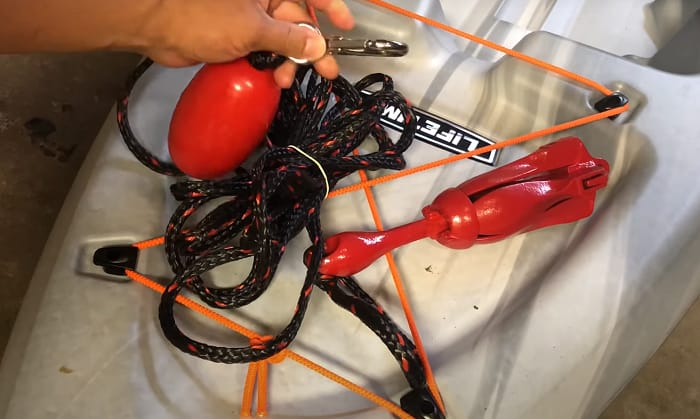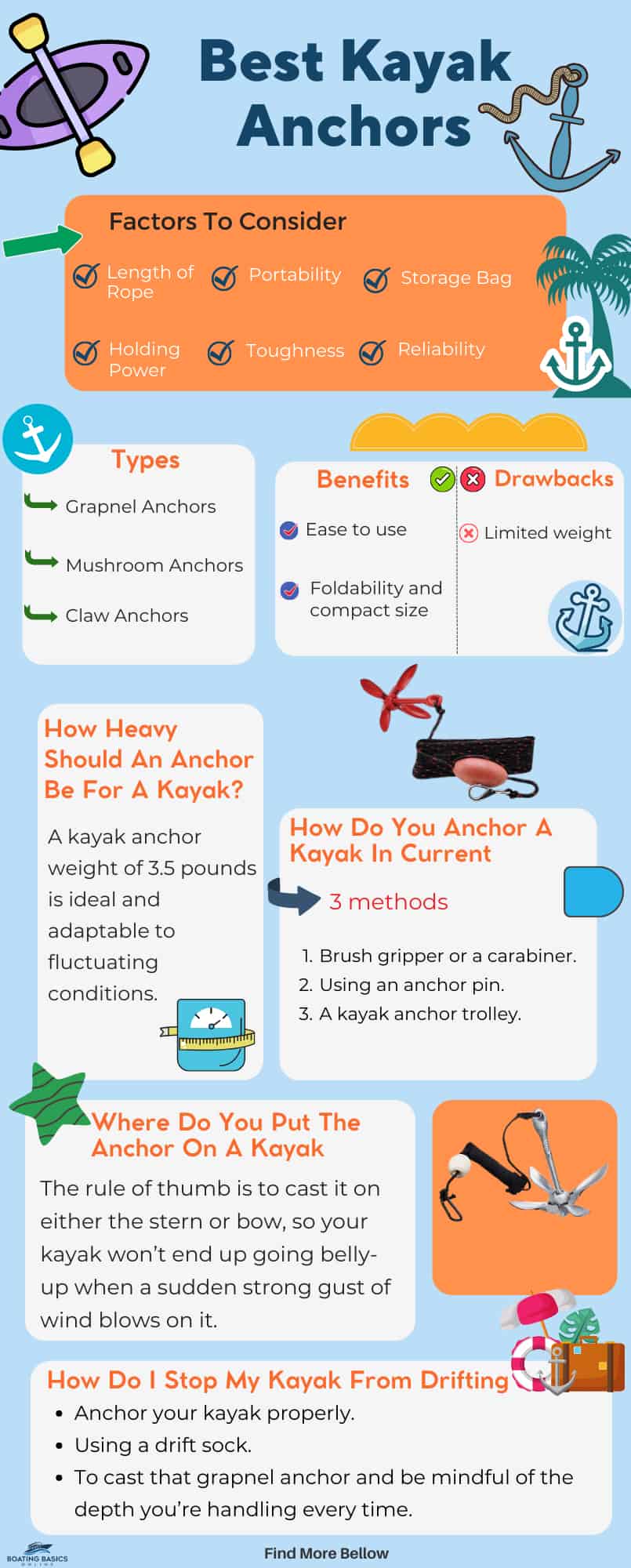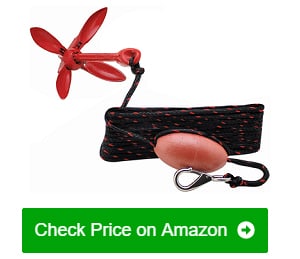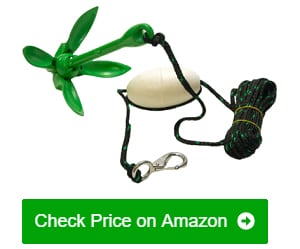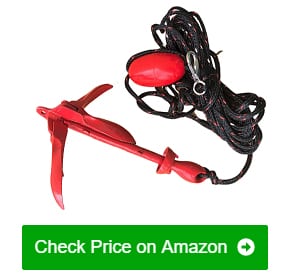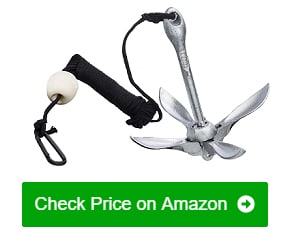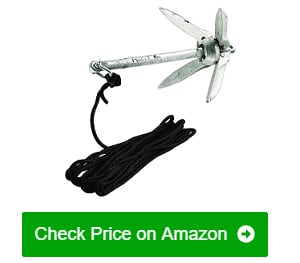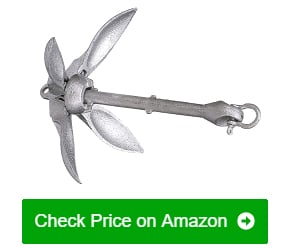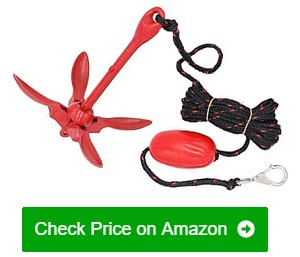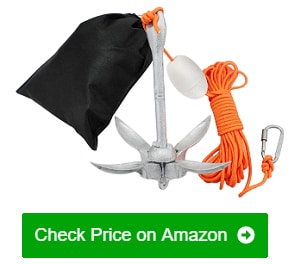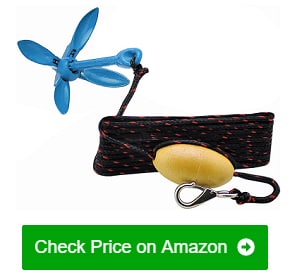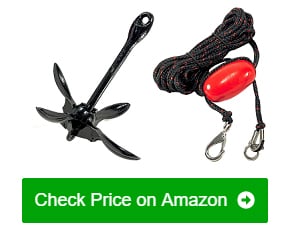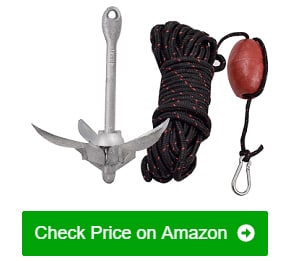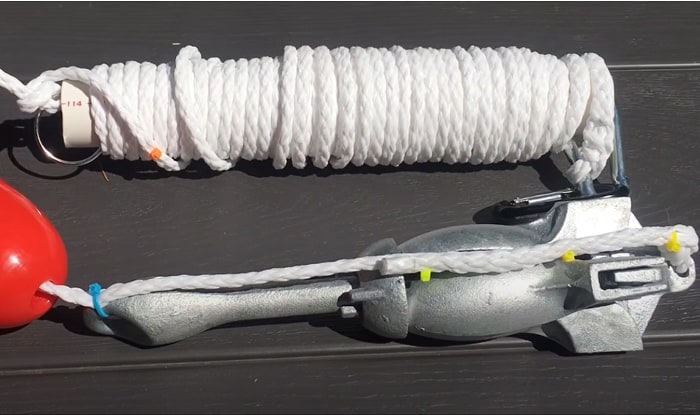If you think there’s only a one-size-fits-all anchor for any kind of kayaking trip is rare. You may argue that folding grapnels, being ever-present in most kayaking stores, make the best kayak anchor. But what if you suddenly find yourself facing rougher waters or a windier than normal day?
More importantly, are you sure that that’s the most suitable anchor to use for the bottom of the lake, ocean, or river you’ll be kayaking in? Ultimately, the top-tier anchors for kayaks are the ones that anticipate and meet these requirements and challenges. And, yes, there are folding fluke anchors out that can do just that; most of them are featured in this review.
If you want to know the most important factors to look at, always remember these three:
- Holding Power: This is mostly dictated by the weight of the anchor, but you can count on its design as well. We can’t ignore the fact that the line used, such as the rope included in the kit, contributes to this aspect as well. It has to be able to keep you steady based on the specific conditions of the water and weather.
- There are grapnel anchors that weigh less than 2 pounds, and based on my experience, these are best for calm and still waters. Those from 3.3 to 3.5 pounds tend to be the most versatile as they anticipate any additional pressure or force that may come from changes in the current and wind.
- Toughness: Anything that has a galvanized finish has good rust protection. Galvanized steel anchors are lauded for their ability to last for decades. However, if you’re going to be using them on saltwater lakes or oceans, their coating may come off faster and last at most 10 years.
- Other anchors go further by incorporating stainless steel, which is more durable and saltwater-friendly. You’ll find plenty of clevises and clasps made of stainless steel, and that’s a plus for obvious reasons.
- Reliability: Does it work well with all the components, such as the rope and buoy, in mind? Anchors will only perform stellarly if these items perfectly complement it. As much as possible, everything included in the kit should be able to work together from the moment you get them set up.
Most of these ropes are made of polypropylene, polyester, or nylon. You want to aim for the latter as much as possible if you want the best experience. That being said, 8-strand double braided rope, usually regardless of its material, lends the most in holding strength and durability.
Plenty of buoys either come with foam or PVC material. PVC is the gold standard when it comes to handling more turbulent marine conditions.
In the next section, I’ve featured 11 of the most exceptional kayak anchors I’ve owned. Most of them perform spectacularly in rocky, sandy, and weedy bottoms, with differences in holding strength and durability. Read on to know my first-hand experience with each one.
- Saltwater-friendly
- Corrosion-resistant
- Superior holding strength
- Sturdy padded bag
- Adequately reliable rope
- Superb performance overall
Table of Contents
- 11 Best Kayak Anchor for Kayak Reviews
- 1. Extreme Max 3006.6548 Grapnel Anchor
- 2. Gradient Fitness Marine Anchor
- 3. Airhead A-Z Complete Grapnel Anchor
- 4. Best Marine Kayak Anchor
- 5. Attwood 11959-1 Universal 3 lb Marine Grapnel
- 6. Seachoice Folding Grapnel Anchor
- 7. ISURE MARINE Kayak Anchor Kits
- 8. AITREASURE Small Boat Anchor Kit
- 9. XIALUO Kayak Anchor Kit
- 10. RUNADI Folding Anchor
- 11. Acelane Kayak Anchor
- Factors To Consider When Choosing A Kayak Anchor
- How Heavy Should An Anchor Be For A Kayak
- How Do You Anchor A Kayak In Current
- Where Do You Put The Anchor On A Kayak
- How Do I Stop My Kayak From Drifting
- Conclusion
11 Best Kayak Anchor for Kayak Reviews
1. Extreme Max 3006.6548 Grapnel Anchor
This makes an awesome, budget-friendly ocean kayak anchor since it handles coral and rocky bottoms extremely well. It handles heavy loads with ease and has plenty of versatile aspects.
This is my anchor of choice if I’m kayak fishing in the ocean. That being said, it’s sturdy enough to handle freshwater applications, too. It hasn’t shown any sign of corrosion after three years of on-and-off usage, but I do make it a point to wash it following every saltwater application.
It’s sufficiently stable once it gets a good hold of the rocky bottom or coral you deploy it in. The 3.5 weight proves to be ideal for kayaks that are a little over 12 feet, which is the average size anyway. That being said, it’s versatile in that it can even keep a 12-foot Jon boat in place in 15mph winds.
Another minor perk I like is that it’s painted with a bright red color. I once misplaced it during a fishing trip to the Keys, and it didn’t take long for me to discover that I had left it next to some canopy trees. It’s certainly appreciated by those who like to fish or row solo.
While the rope has a notably excellent braid, it’s not really as tough as I’d like it to be. Mine frayed after less than a year, so I had no choice but to replace it with a nylon one. I’m not much of a fan of the short 25-foot length, too, as 50-footers often hit the sweet for me.
- Superior holding strength
- Saltwater-friendly
- Red color aids visibility
- Corrosion-resistant
- Versatile and provides good value for money overall
- Subpar rope and buoy
2. Gradient Fitness Marine Anchor
This is one of the better kits I’ve bought in all my years kayak fishing. Every tool included deserves to be praised for its overall quality and performance.
I’m going to start with the least satisfactory, namely the rope. While it’s limited by its 25-foot length, it’s actually made of high-quality, marine-grade materials and is braided nice and tight. If the depth’s just right, I don’t hesitate to use it with this grapnel anchor; otherwise, I swap it for something longer.
Next is the padded bag that comes with this kayak fishing anchor. It deserves a special mention because of how well it is designed. The padding is extra thick and feels sturdy, which gives me the impression that it’s made to ensure the anchor won’t tear through it or any other sharp item for that matter.
The buoy-anchor combination works as smooth as butter. The PVC buoy feels tough and can handle moderately strong waves. The anchor itself holds most standard kayaks in place even in rougher-than-normal marine conditions. As long as you’re aware of basic anchoring techniques, it will do a fine job every time.
I don’t have anything to report about the durability yet since it’s been with me for a little over a year. Of all the items included, I’m betting most of my money that the anchor will outlast everything else.
- Adequately reliable rope
- Sturdy padded bag
- Superb performance overall
- PVC buoy complements the capabilities of the anchor well
- Rope could be longer
- Doesn’t really do that well on muddy bottoms
3. Airhead A-Z Complete Grapnel Anchor
This is another example of a well-designed and reliable grapnel anchor delivering stellar performance. It works well in slightly muddy bottoms, too.
This works best as a small anchor for kayak, given the weight. It’s a little heavier than the average 2+ pounds of weight of most anchors for a solo vessel, but it’s hard to deny that its weight of a little more than 3 pounds contributes to a terrific holding power, especially in choppy waters.
Do take note that compared to other grapnels I’ve used, this one’s more suitable for calmer waters and wind that blows less than 10mph is suitable. and I can’t stress enough that it’s not ideal if the current becomes a little too strong, unless you change up its rope and add a chain.
In the end, what makes it extra special to me is that it fulfills its promise of handling muddy bottoms. That’s rare for a grapnel, and I can vouch for its suitability in mud, as long as the mud doesn’t go overboard. You better be prepared to clean it thoroughly once you decide to deploy it in such bottoms, though.
Its performance on rocky and sandy bottoms is what you’d typically expect from a grapnel folding anchor. It’s been with me for more than two years, and it hasn’t shown any sign of rust or damage. I like that the manufacturer goes all the way in ensuring it lasts long by including a nylon case.
- Stellar strength
- Works best in calm waters
- Can handle slightly muddy bottoms
- Superb durability
- Includes a nylon case for more protection
- Rope is rather short
4. Best Marine Kayak Anchor
For reliability alone, this anchor deserves a spot here. This is a solid grapnel anchor made of galvanized steel. That means it’s marine-friendly and can last for a long time of regular use. It’s what you would expect from a standard galvanized anchor, so that definitely earns a checkmark from me.
What sets it apart is its holding power. It can keep my kayak steady while fishing even in moderately strong currents. It’s got the strength, and I only know a handful of grapnels that I can safely say truly has that coveted quality.
It performs spectacularly as long as the bottoms are on the rocky/sandy or fully rocky side. You won’t lose it when it snags if you tie it with the usual zip tie rigging setup. In fact, I can argue that it’s nothing short of necessary when you’re using a kayak where there’s limited leverage.
Out of all the ground tackle bonuses, I like that they chose to include a buoy ball and a storage pouch. The latter keeps it from getting damaged once stowed and makes storage uncomplicated. I appreciate the stainless steel clip for relatively obvious reasons, too.
Although the rope is sufficiently long at 40 feet, the polyester used is pretty standard at best. I’ve since replaced mine with a nylon one that spans 100 feet. If you’re wondering whether this anchor supports lines that long, then you can take it from my experience that it does.
- Superb holding power
- Works well in both calm and moderately strong currents
- Adequately durable
- Good value for money
- Included rope is just average
- A bit difficult to clean
5. Attwood 11959-1 Universal 3 lb Marine Grapnel
If you’re feeling a bit stingy, this folding anchor for kayak is an awesome choice for its reliable holding strength and, of course, budget-friendly price tag.
The main strength of this Attwood offering is the anchor itself, and most of it is due to the efficient use of the standard folding fluke design and suitable weight. It’s got stable holding power as long as you know the conditions that it can handle. It withstands winds that blow a little over 15mph, but anything more than that may not be fit for a standard-sized kayak.
Don’t settle for the simple knot that the anchor and rope come in because I’ve tested it out and the anchor didn’t take long to fall off in the water. Make sure you tie it into a good anchor knot with a zip tie. There’s literally no better knot than that for any kind of kayaking.
I’ve been using this anchor on and off for over five years, and it hasn’t rusted yet, so I have to commend the galvanizing done on it. I do make sure to wash it immediately every time I deploy it in saltwater or freshwater lakes.
Don’t even get me started on the rope this comes with, though. I know polypropylene has been notorious for its substandard performance compared to other materials, but this one is just not marine-friendly and durable. Mine has started to fray after a few months of use.
- Cheaper than most
- Works well with a good anchor knot
- Sufficiently durable
- The anchor alone provides excellent value for money
- Poor-quality rope
- Flimsy mesh bag
6. Seachoice Folding Grapnel Anchor
This anchor for kayak fishing and sailing is one of the most well-designed and low-cost marine products available in the market. It can beat other anchors in the same price range because of that duo of qualities alone.
This is quite possibly one of the most no-nonsense and highly dependable anchors I’ve bought. When I tried it out for the first time, I already knew that its designers knew what’s been missing in standard folding anchors and provided the answers through this product.
For one, it actually locks in place for both its open and closed position. An often-overlooked downside of folding grapnels is that they may end up unfurling while stored, and they accidentally cut the bag they’re stored in. Another perk of the lock is that it adds an extra layer of security once you deploy it – you don’t have to worry that any of the flukes may lose its hold.
That aspect, plus the anchor’s superior holding strength, makes it a top choice for any time. It’s excellent for both calm and flowing currents. I’ve yet to try it in winds that are above 10mph, but I can safely say that it keeps my kayak stable even if there’s constantly moderate flow.
The galvanizing job performed on it is worth noting. It doesn’t miss out on any spot or nook and cranny at all, so I’m confident that it will beat back rust as long as possible. It helps if you keep it dry the moment you haul it up every time.
- Excellent design
- Superior holding strength
- Great galvanized finish
- Plenty of weight options
- Lighter varieties could be larger
7. ISURE MARINE Kayak Anchor Kits
ISURE’s kayak anchor kit gets plenty of the essentials, like design, weight, and holding power right.
I always look at holding power when ranking kayak anchors. This one delivers consistently in waters with a slightly strong flow. I’ve used it regularly in Stockton Delta where the breezes can stay at 6mph sometimes, and this anchor handles them like a pro.
The weight feels just right, still manageably lightweight but doesn’t fall short in providing the heft necessary to keep your vessel from drifting. And, yes, this anchor shines the most in lakes and rivers with a constant flow.
Based on my experience, the rope’s length is right for plenty of shallow rivers in the US. I always prefer longer lengths, but the fact that I didn’t have to make any adjustments when using it in some choice spots in Stockton Delta speaks volumes about the brand’s awareness of anchoring needs when kayaking. I’m not sure what it’s made of, though, so the question of its durability still hangs.
The kit as a whole is well worth the economical price. Since I benefited from everything included, I feel I got my money’s worth through and through.
- Above-average holding strength
- Usable rope
- Weight is manageable and adequate for constantly flowing currents
- Good value for money
- Carbon steel doesn’t offer optimal rust protection
8. AITREASURE Small Boat Anchor Kit
My go-to anchor for serene fishing spots, AITREASURE’s kit gives you a folding anchor that gets the job done and a rope that offers superior horizontal drag power.
I was honestly a bit hesitant in purchasing this because it’s made of carbon steel. However, I was convinced in the end by the excellent galvanizing work that was done on it. I’m fairly confident that it will hold for a long time and prevent rust since I’ve owned other anchors that have a similar outstanding finish.
Likewise, the construction feels sturdy overall. Don’t be fooled by the small size of the 1.5-pound variety. It’s as solid as any heavyweight and certainly gets the job done, as long as you stick to waters on the calm side.
I had a little trouble with it in Clear Lake once, when the winds reached 15mph. However, as long as the winds stay below 4mph, and the currents are not too strong, it will keep your vessel in place. I haven’t tried the 3.3-pound option yet, but if it’s the same design and construction, I’m betting it will be able to handle choppier waters and weather.
The fact that the polypropylene rope spans a little over 30 feet already convinced me that it hit the right length in the bull’s eye, especially for achieving optimal holding power when kayaking. It’s made of higher-quality polypropylene, and I like the tightness of the braiding, too. I rarely say that I get the most out of everything included in an anchor kit, but this brand’s rope earns a thumb’s up from me.
- Excellent galvanized finish
- Ideal for calm waters
- Superior rope
- More compact and lightweight
- Weight may fall short sometimes
9. XIALUO Kayak Anchor Kit
I use this as a secondary anchor when I’m fishing and rowing in peaceful ponds and lakes. I like its overall usability, light weight, and value for money.
This is a 1.5 lb kayak anchor that only works best if there is minimal to zero flow. With that in mind, I suggest you consider this anchor only if you’re already highly familiar with the usual wind conditions in the pond, lake, river, or ocean you’ll be using it in. Don’t expect to get much out of it from ocean use, unless you stick to docking on beaches.
As far as performance goes, it will keep you in place during days when the winds are virtually nonexistent. Thankfully, I have a pond near my home where that’s almost always the case. I also only have to deal with at most 4 feet of depth, so the 30-foot rope it comes with suits my purposes.
At best, you have to be choosy in the water conditions that you deploy it in. I suggest you do plenty of docking with it, too, or any marine activity that deserves to be labeled as casual. It’s just as easy to deploy as it is to bring along with you because of the compact size and manageable weight.
The price makes it one of the cheapest kayak anchoring systems available today. Considering that and the overall performance, I won’t hesitate to say that this gave me amazing value for my money.
- Performs stellarly in windless days
- Lightweight and compact
- Suitable for docking
- Budget-friendly
- Great value for money
- Application limited to calm waters
- Smaller than the average lightweight anchor
10. RUNADI Folding Anchor
This is another kayak anchor kit that has mostly superb items. The 3.5-pound anchor will hold on moderately flowing water and works well with the accompanying adjustable buoy and adequately long rope. The cherry on top is the durable nylon bag.
This was actually gifted to me by my wife. She definitely knows what I want in my folding anchors, considering, for example, the generous amount of rope it comes with. Even if it goes over what I need for a specific depth, it’s easy to tie into knots to shorten.
The anchor holds extremely well even if there’s consistent flow and can keep you steady if you’re dealing with sudden gusts of wind. To me, it gets the weight and size right, especially with the way it smoothly works with my trolley setup. Everything, including the clevis, is well-made and of solid construction to aid in durability.
I’ve only acquired this last year, so I can’t share my two cents yet on its longevity. Based on my experience with anchors with a similar construction, I won’t be surprised if it lasts for a few years or even a decade before the coating wears off. Of course, that comes from someone who’s meticulous in rinsing anchors after every saltwater use.
It’s still highly portable because of the size and weight. I love the padded nylon bag it comes with because you immediately know that it deserves the “durable” label by feeling it and how it accommodates the anchor once you store it.
- Performs well in moderately strong currents and winds
- Near perfect size and weight for its purpose
- Solid construction
- Line length doesn’t fall short for most kayaking purposes
- High-quality nylon bag
- Black color makes it difficult to see
11. Acelane Kayak Anchor
If performance, durability, and design are the sole factors, I’m all too willing to label this as the best. Its included rope and buoy deserve the spotlight as well.
This convinces me that 3.5 pounders are the most reliable and ideal anchor weight for kayaking. I can say it’s just as exceptional in its performance as the RUNADI grapnel I featured above. I use it to keep my 15-foot kayak in place during windy days in Clear Lake, and after less than 6 months of regular use, it hasn’t given me any issues.
Galvanizing job done on it sealed the deal for me already. I believe it deserves a solid grade A rating with how they did it, and I can prove that it withstands saltwater use well after regular fishing trips to Big Lagoon in a span of 6 months.
The rope included is a double-braid and can handle up to 2,200 pounds. It spans 50 feet at most, and I can easily adjust it with a Prusik knot till I get the optimal length for the current depth. It’s easy on my hands, so I can make these adjustments without much hassle.
The buoy is made of PVC material, so I have no doubts that it can handle the pressure from more powerful waves. I like the red color as it readily stands out but not overly so. They didn’t skimp on the nylon storage bag as well, and I love that its durability and construction match well with the quality of the other tools it houses.
- Superior performance during windy days
- Excellent rope, buoy, and nylon storage bag
- Stellar galvanized finish
- Provides exemplary value for money
- Anchor could be a bit larger
Factors To Consider When Choosing A Kayak Anchor
Length of Rope
When kayaking, you want to pay more attention to the water’s depth relative to the rope you have. Some sailors suggest having 7 to 10 times the depth, but based on my experience it’s best to stick to 7 feet of rope for every 1 foot of depth.
For example, if you’re kayaking in a depth of 5 feet, you’ll need exactly 35 feet of rope. Take note that some kits only include a 25-foot rope, so keep this in mind to avoid falling short of your requirements.
Portability
You want your canoe anchor system to not be as heavy and bulky as possible considering the limited capacity of your vessel. This is why I don’t recommend going for anchors that go above 3.5 pounds.
This takes into consideration the size of the anchor as well as its ease of storage and transport. While it may seem fine to have a smaller anchor, their size could prove to be a disadvantage in that they’ll be harder to see or may not engage or lodge as easily as their larger counterparts.
Storage Bag
You can’t overlook this because some grapnel anchors have a poor locking mechanism, causing their flukes to suddenly engage without you intending them to. This may cause untoward accidents.
Since the bag makes transporting these anchors uncomplicated, you want them to be able to handle the weight and possible hazard risk that they may cause. Padded bags made of nylon provide that extra layer of much-needed security.
The Different Types of Kayak Anchors
- Grapnel Anchors
These remain the most popular choice because of their amenability to rocky and weedy bottoms. Both are common conditions that most kayakers have to deal with. They’re not difficult to get the hang of, lightweight, compact, and budget-friendly. They may work on muddy bottoms sometimes, but grapnels that do so are almost always exceptions to the rule.
- Mushroom Anchors
Should your grapnel struggle to hold in muddy bottoms, a kayak mushroom anchor can serve as a ready workaround. These anchors pull no punches when imparting holding strength; however, they tend to be used only for more extensive anchoring and docking purposes that last for days and weeks.
- Claw Anchors
While I prefer grapnels, I consider claw anchors the most versatile of the three. As long as their size can accommodate my kayak, I tend to bring them along. They’re not hard to set because they hold well on most types of bottoms. Another perk is that they automatically align with the wind and tide.
If you have time, I suggest you watch this video to gain more practical information about the three types:
Benefits and Drawbacks of a Kayak Anchor
Kayak anchors like folding grapnels are well-loved because of their ease of use. You only need to engage their flukes, lock them in place, tie them with a good anchor knot, then cast and set them. In most cases, you won’t struggle so much in getting them set and engaged.
Their foldability and compact size allow them to be easily brought along any kind of solo fishing or rowing trip. Most don’t cause an arm and a leg unlike other more heavy-duty anchors out there. In short, they’re designed specifically to fulfill the specific anchoring requirements of a kayak.
As for disadvantages, I can say that their manufacturer’s decision to specialize in fulfilling those requirements can be a double-edged sword sometimes. For one, their limited weight means you can’t really be 100% sure they’ll hold if the weather becomes more extreme.
What’s good is that kayak anchor ideas are continuously evolving and fresh solutions are being introduced with every new anchor kit being released nowadays.
How Heavy Should An Anchor Be For A Kayak
I’ve had plenty of people ask me, “what size anchor for kayak?” and almost every time, I suggest they focus on the weight of the anchor. After decades of kayaking, I can safely say a kayak anchor weight of 3.5 pounds is the most ideal and adaptable to fluctuating conditions.
Having that much weight means you don’t go overboard even if the tide and currents are still, at best. The additional poundage means you’ll have a blanket of security and stability to maintain the holding power, even if the winds begin to blow at, for example, 7 or even 10mph.
How Do You Anchor A Kayak In Current
In currents, I’d rather rely on a brush gripper or a carabiner hook first to get a solid hold with ease. I just paddle close to a log or any debris that the gripper can get a solid hold on or that I can securely tie the carabiner’s rope to before locking it in place. Afterward, I tie it to my anchor cleat then drop my grapnel anchor, assuming the depth’s just right.
Another method involves using an anchor pin. Since your vessel is constantly moving, you should start by paddling backward toward the bank the moment you’ve decided on an anchoring spot.
If you have a kayak anchor trolley (and I highly recommend that you get one!), you can stick your anchor pin to the ground then secure it to the anchor cleat. Of course, that’s just one setup, since you can attach the pin to the trolley, too.
These methods tend to work only if the currents are minimal to moderate. Otherwise, it will be hard to paddle backward.
Where Do You Put The Anchor On A Kayak
The rule of thumb is to cast it on either the stern or bow, so your kayak won’t end up going belly-up when a sudden strong gust of wind blows on it. One technique I learned a master from Reddit when I was a beginner and continue to apply today is using an anchor trolley.
It allows me to easily make adjustments to my anchoring position when the wind and the currents change. That’s another compelling reason why you should consider investing in one.
How Do I Stop My Kayak From Drifting
There’s really no better solution to this than to anchor your kayak properly. There are ways to slow your drift, like, for example, using a drift sock. However, if you want to stay in place, you need to cast that grapnel anchor and be mindful of the depth you’re handling every time!
Conclusion
As a closing note, let me sum up my points. The best kayak anchor will always be the one that fits your anchoring setup and preferences. If you’re a frequent fisher in still waters, there’s no reason to buy anything over 1.5 pounds, but if you want more versatility, I suggest you aim for at least 3 pounds.
Be mindful of the galvanizing work or the materials it uses overall. Lastly, make sure you match every essential anchoring tool with its functionalities and requirements. This is the only way to keep your anchoring endeavors while kayaking hassle-free and smooth sailing every time.

“My intention from the first day establishing Boating Basics Online is to provide as much help as possible for boaters who want to experience a first safe and convenient trip. So feel free to join us and share your beautiful journeys to the sea!”

